by Naomi L. | November 9, 2016 | Blog, Creative Writing, Featured |
Rhetoric: the beautiful art of persuasive speaking and writing that all ambitious people strive to master. It’s a powerful tool for success; within a social and communicative species like ours, so many goals can be achieved simply through the use of effective speech and composition. English is rife with handy rhetorical devices, and while you work on that NaNoWriMo novel, you should consider how to use language to its greatest potential, as much among your characters as with your audience.
So for your reference, here is a list of six popular rhetorical devices, complete with explanations and examples for how to use them. Enjoy!
1) Analogies are as easy as pie.
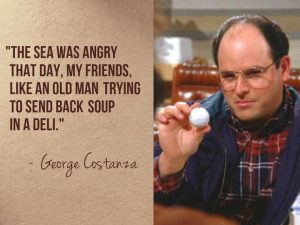
The sea was angry that day, my friends, like an old man trying to send back soup in a deli. – George Costanza, Seinfeld (Season 5, Episode 14 – The Marine Biologist)
(Image source: Playbuzz)
The analogy is one of the first rhetorical devices we learn to use in school. The basic formula is simple: take two similar ideas and connect them with “as” or “like” (which gives you a simile). They can also be more complex, making use of similes and metaphors to strengthen a comparison in the minds of readers and listeners, thus leaving a lasting impression on the audience.
Analogies are particularly useful for making complex ideas accessible by comparing unfamiliar concepts with familiar ones. Aside from providing simple explanations, they can also be used to create vivid images that engage the audience, such as “autumn leaves falling like golden rain” or “a young lady as beautiful and delicate as a rose”. Try not to use too many analogies at once, though; constantly comparing one image to another will not only get tiresome quickly, but could give the impression of unoriginality, especially if you’re comparing your work to someone else’s. Don’t make your stories as average as the next person’s!
2) Hyperbole is the greatest rhetorical device ever created!
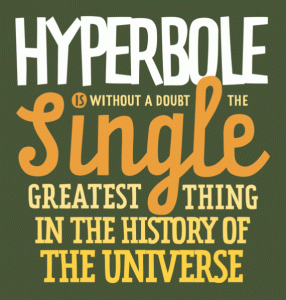 There’s nothing like exaggeration to get a point across. Who among us hasn’t shared our experiences of “the greatest thing ever”, “the worst day in history”, or “the most fun I’ve ever had in my entire life”? Hyperbole is a common device for creating emphasis, as exaggeration tends to have a great impact on an audience’s perceptions of a given description.
There’s nothing like exaggeration to get a point across. Who among us hasn’t shared our experiences of “the greatest thing ever”, “the worst day in history”, or “the most fun I’ve ever had in my entire life”? Hyperbole is a common device for creating emphasis, as exaggeration tends to have a great impact on an audience’s perceptions of a given description.
If you think about it, it’s funny how we’re inclined to exaggerate so often. After all, nobody literally “dies of embarrassment”, bags don’t literally “weigh a ton”, and friends don’t literally “go forever without seeing each other”. Yet we excuse this lack of literal sense in favor of the bolder imagery that fascinates us so, as if reaching to the limits of our imagination and beyond is simply second nature.
While it shouldn’t be used in excess, hyperbole is a good addition to any conversation that calls for dramatic emphasis. Have your characters use this device to add an informal or amusing tone to your dialogue, while in narrative you can use it to demonstrate intensity or create contrasts with normal descriptions. Use it wisely, and the hyperbole may just help you write the best stories ever!
3) Metaphors are a piece of cake.
All the world’s a stage,
And all the men and women merely players.
– William Shakespeare, As You Like It
Ah, metaphors: the celebrated heroes of poetic language. This is an especially popular device in rhetoric, using figurative speech to make strong comparisons where literal expressions would fall short. A close cousin of the simile and building block of the full analogy, the metaphor is an effective tool for constructing imagery that appeals to the audience’s imagination and draws them further into a story. Why say a soldier is “brave” when you can call him a “lion”, or say that a sound is “sweet” when you can call it “music to one’s ears”?
Metaphors have become so pervasive in modern language that we don’t even realize how heavily we rely on them in everyday speech. We suffer “broken hearts”, laugh “our heads off”, cry “rivers of tears”, and “bottle up” our anger. We’re “early birds” and “night owls”, “open books” and “loose cannons”, “black sheep” and “couch potatoes”, all lost in a “sea of faces” in the great “melting pot” that is our world. Is it even possible to speak completely literally anymore? I can only imagine how hard (and fun) it must have been to write Drax’s lines for Guardians of the Galaxy!
The metaphor is useful for creating impact in a story, so long as it’s used sparingly and with good timing. If you find your writing is lacking some flair, a well-placed metaphor, whether short and sweet or long and complex, may be just the thing to “brighten up” your story and “paint a colorful picture” in your readers’ minds!
4) Oxymorons are stupidly brilliant!
And faith unfaithful kept him falsely true.
– Idylls of the King (Alfred Tennyson, 1859–1885)

Good night, good night! Parting is such sweet sorrow / That I shall say good night till it be morrow. – Juliet Capulet (Romeo & Juliet, 2.2.185–86)
(Screencap source: Romeo + Juliet, 1996)
This is one of my favorite rhetorical devices, for even though I don’t use it often myself, I enjoy the comical irony of using opposites to create a coherent phrase. The oxymoron is a figure of speech formed by combining contradictory terms, which often leads to humorous results: “jumbo shrimp”, “found missing”, “act naturally”, and so on. Some are even taken for granted as commonplace expressions, such as “virtual reality” and “science fiction”. And what horror fan could forget the classic “living dead”?
The beauty of the oxymoron is that it can just as easily slip by unnoticed as it can make us pause to think when pointed out. In rhetoric, this device can be used to create a paradox and draw attention to a contradiction, such as in Romeo’s criticism of the contrasts of love in Shakespeare’s Romeo & Juliet:
O heavy lightness, serious vanity,
Misshapen chaos of well-seeming forms!
Feather of lead, bright smoke, cold fire, sick health,
Still-waking sleep, that is not what it is!
– Romeo Montague (Romeo & Juliet, 1.1.184–87)
Overall, oxymorons are good for creating dramatic effect in poetry and in prose. They’re also popular as satirical devices, and can make great additions to a piece of humorous writing. So the next time you feel stuck writing comedy, why not try making opposites attract? You may be able to create some “seriously funny” works!
5) I’m not saying paralipsis is an evasive maneuver, but…
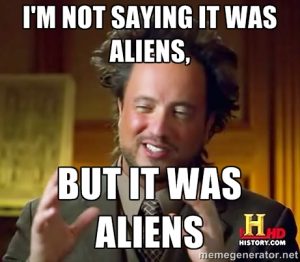 This one was recently featured as a Word of the Week on my blog. It’s common to hear people use such phrases as “I’m not saying”, “not to mention”, and “needless to say”, only to immediately follow them up with a piece of information they just said they wouldn’t talk about. This is known as paralipsis, an ironic way to draw attention to a subject by explicitly stating you won’t mention it.
This one was recently featured as a Word of the Week on my blog. It’s common to hear people use such phrases as “I’m not saying”, “not to mention”, and “needless to say”, only to immediately follow them up with a piece of information they just said they wouldn’t talk about. This is known as paralipsis, an ironic way to draw attention to a subject by explicitly stating you won’t mention it.
A relatively colloquial device, paralipsis is used most effectively in speech rather than in writing, making it a good choice for character dialogue. One of the most notable examples in literature (as pointed out by Mike of M.C. Tuggle, Writer) is Mark Antony’s speech in Shakespeare’s Julius Caesar, in which Antony brilliantly uses this device to turn the crowd against Brutus and the other conspirators:
Have patience, gentle friends, I must not read it;
It is not meet you know how Caesar loved you.
You are not wood, you are not stones, but men;
And, being men, bearing the will of Caesar,
It will inflame you, it will make you mad.
‘Tis good you know not that you are his heirs;
For if you should, O, what would come of it!
– Mark Antony (Julius Caesar, 3.2.139–45)
In rhetoric, paralipsis has several uses: to indirectly point something out, to make a passive-aggressive comment, to criticize someone without being held accountable, or to explain something while politely avoiding a suggestion of ignorance (or, alternatively, to make a sarcastic comment about the audience’s ignorance). Though it should be used carefully, this is a highly effective device that can make for some exceptionally persuasive speech. I’m not saying it’ll help you reach or even surpass the level of your favorite authors, but learning to use paralipsis well will definitely improve your proficiency as a writer!
6) I love when people take sarcasm seriously.
Irony in its sharpest form, sarcasm is hailed as one of the most beloved tools in the comedic arsenal – so much so, that it’s become nearly impossible not to hear it in some form or other in everyday speech. Sarcasm is basically the use of wit to make a point, typically in a bitter way that conveys contempt. This device comes in many flavors, including deadpan, self-deprecating, manic, and even polite. It’s used to amusingly draw attention to the obvious, to mock oneself or others, or simply as a coping mechanism to make the frustrations of life a little more bearable. I know I’ve had those days that I couldn’t survive without a little sarcasm to tide me over!

Leonard has to clue Sheldon in on Penny’s sarcasm (The Big Bang Theory: Season 1, Episode 2 – The Big Bran Hypothesis)
(Image source: Tumblr)
Given its acidic nature, sarcasm is best exercised with caution. Like most humor techniques, it’s hard to teach because each person uses it differently and even harder to master because not everyone understands it, but sarcasm in particular is worth the effort as it’s a strong indicator of the writer and the readers’ intelligence. Use it in dialogue to demonstrate a character’s sharp wit or occasionally in narrative to indirectly criticize people and society, and if you must use it to address your readers, at least try not to be too offensive and alienate an audience who have no sense of humor. Or, you know, just do whatever you want. Why give a damn what the rest of the world thinks?
What are your thoughts on these rhetorical devices? Any other favorites you would add to this list?
by Naomi L. | March 23, 2016 | Blog, Creative Writing, Featured |
Writers are everywhere, and with the advantages of the Internet and blogging, it’s never been easier for us all to connect with one another. Blogging is a great way for writers to put themselves out there and gain some kind of footing for their work, but it can seem rather daunting to find ways of reaching potential readers in the vast ocean that is the blogosphere. In fact, this is an art I’m still trying to master myself, and for that I can’t say much on this subject from the perspective of a writer. I can, however, speak as a reader and share how I found over 200 writers’ blogs to follow.
So for those of you constantly seeking inspiration and new friends in the blogosphere, here are the top seven ways that I find writers online. I hope you’ll find these useful too! Enjoy!
1) “Creative Writing” tag in WordPress Reader
 WordPress is the ultimate blogging platform, no contest. With high design flexibility and an integrated blogging network, it’s an excellent choice for writers to start building an online presence, whether it’s free on WordPress.com or self-hosted with WordPress.org. Because my site is connected to WordPress.com through Jetpack, I found it easiest to start searching for other writers through the WordPress Reader. There are several tags through which to find writers’ posts, of course, but already a general search for “creative writing” tends to return plenty of interesting results. There’s always something new to find in the Reader, so checking back regularly definitely helps to expand a followed blogs list!
WordPress is the ultimate blogging platform, no contest. With high design flexibility and an integrated blogging network, it’s an excellent choice for writers to start building an online presence, whether it’s free on WordPress.com or self-hosted with WordPress.org. Because my site is connected to WordPress.com through Jetpack, I found it easiest to start searching for other writers through the WordPress Reader. There are several tags through which to find writers’ posts, of course, but already a general search for “creative writing” tends to return plenty of interesting results. There’s always something new to find in the Reader, so checking back regularly definitely helps to expand a followed blogs list!
2) Twitter
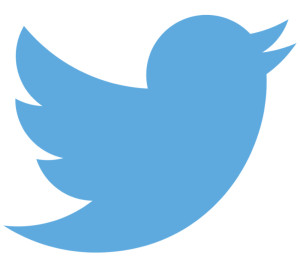 After setting up a blog, the next step for a writer is to create social media profiles. An online network is indispensable for an artist hoping to get their work noticed, and of all the networks I use regularly, Twitter has proven to be a goldmine of writers’ profiles. Author posts and retweets, book promotions, contest invitations, anything writing-related can be found on Twitter, and many of the connections I’ve made on WordPress actually started there. Using hashtags and regularly retweeting other writers have proven to greatly increase one’s following; I’ve found many writers on this network thanks to their mastery of these practices, so if you’re new to Twitter, you’d be wise to try taking them up too!
After setting up a blog, the next step for a writer is to create social media profiles. An online network is indispensable for an artist hoping to get their work noticed, and of all the networks I use regularly, Twitter has proven to be a goldmine of writers’ profiles. Author posts and retweets, book promotions, contest invitations, anything writing-related can be found on Twitter, and many of the connections I’ve made on WordPress actually started there. Using hashtags and regularly retweeting other writers have proven to greatly increase one’s following; I’ve found many writers on this network thanks to their mastery of these practices, so if you’re new to Twitter, you’d be wise to try taking them up too!
3) Writing communities
While I’m not nearly as active in writing communities as I should be, I added this item to my list because some of the few writers I have met through communities are among the writers I’ve connected with the most. The contests and events on Writer’s Carnival (which I found through Twitter) have been a great way to meet and befriend other writers, especially since the community strongly encourages its members to review each other’s work. Among so many other artists sharing the same interests, goals, and fears as you, a writing community is a great place to find new friends!

4) Blogrolls
Want to make sure your blog is connected to the rest of the blogosphere? Use links! WordPress.com blogs come with blogroll widgets that display Gravatars of followers and followed blogs, and I’ve found many new blogs through these links. Self-hosted WordPress bloggers can find alternative widgets in the plugin directory for sharing blogs they like, and other blogging platforms also offer easy ways to showcase links to favorite sites in the sidebar. Blogrolls are handy tools for writers: not only does sharing links throughout your site drastically increase your connection to the blogosphere, but it encourages other bloggers to return the favor, earning you plenty of exposure for a simple kind gesture!
5) Blogging events/writer link-ups
If you’ve been reading my blog for a long time, you may remember that I used to participate in a monthly blogging event called Writers Reveal. This was a blog-swap event where we would send each other topics by email and all share our posts around the same time. It was a good way to connect with and promote other writers, since we always shared links to each other’s blogs at the end of our posts. I’ve met quite a few interesting writers through this event, and even more just by following links in posts for other blogging circles. Participating in blogging events is a great way to make new friends, plus it’s loads of fun!
6) Guest posts
Speaking of connecting with other writers, guest posts are another useful method of forming links between blogs. I’ve found plenty of new writer blogs to follow through links in guest posts, blogs that I might not have found any other way. Similar to blogging events, guest post exchanges strengthen connections between bloggers via links to one another’s sites, helping each writer expand their reach to the other’s audience and introducing all readers to new and interesting content. Win-win-win!
7) Chris the Story Reading Ape (i.e. Reblogs)
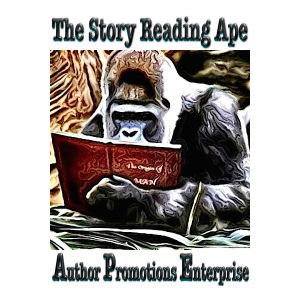 I single out Chris the Story Reading Ape here because he’s pretty much the king of this practice in the creative writing domain, but there are several writers I follow on WordPress who make a habit of reblogging each other’s posts. Chris‘s blog is a goldmine of writing articles and resources, all in the form of reblogs from other writers’ sites. WordPress reblogs always include a link to the original post, so I’ve come across tons of new blogs to follow just by browsing through his archive. WordPress writers, take note: reblogs are a valuable tool for sharing your favorite content and helping writers you like expand their network. The blogosphere grows on a you-scratch-my-back-I-scratch-yours principle; reblogging each other’s posts helps all us writers better connect with one another and expand our voices in the world!
I single out Chris the Story Reading Ape here because he’s pretty much the king of this practice in the creative writing domain, but there are several writers I follow on WordPress who make a habit of reblogging each other’s posts. Chris‘s blog is a goldmine of writing articles and resources, all in the form of reblogs from other writers’ sites. WordPress reblogs always include a link to the original post, so I’ve come across tons of new blogs to follow just by browsing through his archive. WordPress writers, take note: reblogs are a valuable tool for sharing your favorite content and helping writers you like expand their network. The blogosphere grows on a you-scratch-my-back-I-scratch-yours principle; reblogging each other’s posts helps all us writers better connect with one another and expand our voices in the world!
How do you find other writers online? What are the best ways you’ve found to attract followers to your blog?
by Naomi L. | May 20, 2015 | Blog, Creative Writing, Featured |
I love colors. I’ll say it over and over again: I love colors! They’re beautiful. They’re stimulating. Sometimes I even think they’re magical. I love everything about them, from the power they have to evoke emotions to the subtle yet distinct differences they make in a work of art. But my favorite thing about colors is their symbolism, the way they can be used to hide secrets and hint at details of a bigger picture without drawing focus away from the story at hand.
It’s simple enough to use colors in visual art, but what about in writing? Challenging as it may seem, I believe it is possible to create symbolism with words, such as when describing color schemes of character outfits and settings. Color symbolism has fascinated me for as long as I can remember, and while it would take an entire book (or series of books) to get into it all, I’d like to at least scratch the surface today with some of the basics I’ve picked up throughout my experience researching and implementing meaningful colors in my stories. You may want to consider these tips the next time you set a scene; they can help add a vivid new layer to your story! Enjoy!
 Red – Red is a bold and passionate color, often symbolizing such strong ideas and images as courage, fire, power, and violence. It’s a color that demands attention, which is why it’s commonly used to signify danger. Use red for passionate or aggressive characters, or for any sort of intense scene, whether it’s the heat of love or the violence of war.
Red – Red is a bold and passionate color, often symbolizing such strong ideas and images as courage, fire, power, and violence. It’s a color that demands attention, which is why it’s commonly used to signify danger. Use red for passionate or aggressive characters, or for any sort of intense scene, whether it’s the heat of love or the violence of war.
 Orange – Not quite passionate and not quite joyful, orange is a middle ground between red and yellow. It symbolizes energy and creativity, and is used in psychology to stimulate enthusiasm and determination. Use orange for adventurous or creative characters, or when you want to paint some vibrant warmth into a scene.
Orange – Not quite passionate and not quite joyful, orange is a middle ground between red and yellow. It symbolizes energy and creativity, and is used in psychology to stimulate enthusiasm and determination. Use orange for adventurous or creative characters, or when you want to paint some vibrant warmth into a scene.
 Yellow – Yellow is the two-sided coin of colors. On the one hand, it symbolizes happiness, optimism, sunshine, and friendship. On the other hand, it can also stand for cowardice, illness, hazard, and deceit. Golden shades represent wealth and luxury. Use yellow when you want to add hints of joy or caution to a scene. For the best effect, I recommend using yellow ambiguously, such as for characters who seem jubilant and optimistic on the outside but who are fearful or deceitful on the inside.
Yellow – Yellow is the two-sided coin of colors. On the one hand, it symbolizes happiness, optimism, sunshine, and friendship. On the other hand, it can also stand for cowardice, illness, hazard, and deceit. Golden shades represent wealth and luxury. Use yellow when you want to add hints of joy or caution to a scene. For the best effect, I recommend using yellow ambiguously, such as for characters who seem jubilant and optimistic on the outside but who are fearful or deceitful on the inside.
 Green – Think of green and you’re sure to picture beautiful scenes of nature, complete with lush vegetation as far as the eye can see. Indeed, green is the color of the environment, and it represents such ideas as youth, fertility, health, and rebirth. Abstractly, it also symbolizes jealousy and good luck. Use green for characters associated with natural themes such as environmentalism or the practice of healing, or to hint at fortune or envy in relationships.
Green – Think of green and you’re sure to picture beautiful scenes of nature, complete with lush vegetation as far as the eye can see. Indeed, green is the color of the environment, and it represents such ideas as youth, fertility, health, and rebirth. Abstractly, it also symbolizes jealousy and good luck. Use green for characters associated with natural themes such as environmentalism or the practice of healing, or to hint at fortune or envy in relationships.
 Blue – Blue is my favorite color because it represents all my favorite things. It’s a color that symbolizes intelligence, tranquility, trust, and loyalty. In nature, it’s associated with the sky and the sea, and different shades from turquoise to navy can be used to signify sophistication, knowledge, and integrity. Use blue for characters who are more intellectual than emotional, and for settings fitting an atmosphere of calm and authority.
Blue – Blue is my favorite color because it represents all my favorite things. It’s a color that symbolizes intelligence, tranquility, trust, and loyalty. In nature, it’s associated with the sky and the sea, and different shades from turquoise to navy can be used to signify sophistication, knowledge, and integrity. Use blue for characters who are more intellectual than emotional, and for settings fitting an atmosphere of calm and authority.
 Purple – Purple is the color of royalty, and has long represented such themes as nobility, wisdom, honor, and extravagance. Being a relatively rare color in nature, it is often associated with mystery and magic. Lighter shades such as lavender also convey grace and elegance. Use purple as a motif for regal or arrogant characters, mysterious settings, and storylines brimming with fantasy.
Purple – Purple is the color of royalty, and has long represented such themes as nobility, wisdom, honor, and extravagance. Being a relatively rare color in nature, it is often associated with mystery and magic. Lighter shades such as lavender also convey grace and elegance. Use purple as a motif for regal or arrogant characters, mysterious settings, and storylines brimming with fantasy.
 Pink – A soft complement to the bold red, pink is the color that most famously signifies love and romance. Strongly associated with femininity, it represents tenderness, caring, and acceptance. I myself tend to associate the color pink with flowers. Use pink to add a soothing or feminine quality to a scene, or to signify elements of a romantic subplot.
Pink – A soft complement to the bold red, pink is the color that most famously signifies love and romance. Strongly associated with femininity, it represents tenderness, caring, and acceptance. I myself tend to associate the color pink with flowers. Use pink to add a soothing or feminine quality to a scene, or to signify elements of a romantic subplot.
 Brown – Brown is well known as an earth tone, and as such tends to represent stability. Common ideas associated with the color brown include simplicity, comfort, and endurance. Use brown when you want to convey a sense of plainness or tenacity in a scene without having to resort to the blatant dullness of gray.
Brown – Brown is well known as an earth tone, and as such tends to represent stability. Common ideas associated with the color brown include simplicity, comfort, and endurance. Use brown when you want to convey a sense of plainness or tenacity in a scene without having to resort to the blatant dullness of gray.
 Gray – The dull middle ground between white and black, gray is most commonly associated with boredom and depression. On the positive side, it also stands for security, modesty, practicality, and reliability. Use gray for conservative characters or when you want to create a colorless air for a particular setting.
Gray – The dull middle ground between white and black, gray is most commonly associated with boredom and depression. On the positive side, it also stands for security, modesty, practicality, and reliability. Use gray for conservative characters or when you want to create a colorless air for a particular setting.
 White – White is the international color of peace, and is often regarded as a symbol of light, purity, and faith. Some even go as far as to associate it with perfection. Note that white takes on a different meaning in Eastern cultures, where it’s associated with death and mourning. Use white when you want to convey innocence in your characters and cleanliness in your settings, or when you want to create strong religious symbolism in your scenes.
White – White is the international color of peace, and is often regarded as a symbol of light, purity, and faith. Some even go as far as to associate it with perfection. Note that white takes on a different meaning in Eastern cultures, where it’s associated with death and mourning. Use white when you want to convey innocence in your characters and cleanliness in your settings, or when you want to create strong religious symbolism in your scenes.
 Black – The exact opposite of white, black represents everything that its counterpart doesn’t. Darkness, evil, and death are themes commonly associated with black, but it can also stand for austerity, formality, style, and sexuality. Arguably the most powerful color of all, black has a long history of symbolizing strongly opposed ideas on the spectrum of good and evil. Use black to convey depth in your characters or to add dark themes to a scene. For best results, combine it with other colors to create interesting contrasts of ideas in your stories.
Black – The exact opposite of white, black represents everything that its counterpart doesn’t. Darkness, evil, and death are themes commonly associated with black, but it can also stand for austerity, formality, style, and sexuality. Arguably the most powerful color of all, black has a long history of symbolizing strongly opposed ideas on the spectrum of good and evil. Use black to convey depth in your characters or to add dark themes to a scene. For best results, combine it with other colors to create interesting contrasts of ideas in your stories.
I hope you’ve enjoyed exploring the symbolism of color with me, and that you’ve picked up a few hints along the way! Have fun experimenting with the colors in your stories! Good luck, and thanks for reading!
Do you use color symbolism in your stories? Which colors are your favorites?
References and Further Reading
by Naomi L. | July 2, 2014 | Blog, Creative Writing, Tropes |
Some time ago, I wrote a blog post about a trope known as Chekhov’s Gun, a literary device in which a seemingly unimportant detail later becomes significant to the plot. But what if you want to achieve the opposite effect, that is, introduce a supposedly important detail that later turns out to have little or nothing to do with the main story? Today’s post features a sister trope that’s equally useful and just as fun to write. Do you enjoy misleading your readers with deceptive clues? Then let me introduce you to the next handy tool in your arsenal: the Red Herring.
Herring? Where?
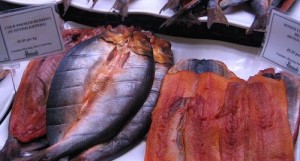
The “red herring” is a type of heavily cured/smoked kipper. The idiom may have originated from anecdotes relating its use as a tool for misleading hunting dogs.
(CC Image by misocrazy via Flickr)
The Red Herring is a common device in fiction, employed by writers who like to keep readers on their toes. Simply put, it’s a clue intended to lead in the wrong direction. This is an especially useful trope for plots that involve a lot of mystery, as misleading details help to keep the element of surprise. After all, a story in which the major secret is easy to deduce from the beginning isn’t really worth the read, is it?
Like the Chekhov’s Gun, a Red Herring generally relies on the principle of conservation of detail to work properly: every detail presented in a story must have a reason for being there, otherwise it should be discarded. Of course, as mentioned above, a Red Herring functions in the opposite manner as a Chekhov’s Gun in that it’s intended to seem important upon its introduction but is later revealed to have been a distraction from the true secret of the story. The challenge for the audience is trying to tell the fake clues from the real ones!
Placing a Red Herring
Although every Red Herring is purposely used to throw the audience off, the best ones still have some significant connection to the plot even after being revealed as false leads. For instance, a clue can be introduced to set up suspicions about a certain character. This character may later turn out to be innocent, but the clue that seemed to be pointing to them justifies another character as the culprit instead. The example provided on TV Tropes is that of suspects in a hypothetical murder case, but I suppose it could apply to any kind of mystery. The only limit is your own imagination!
For writers who like to get really creative, Red Herrings come in different “flavors”. Subtropes include the Red Herring Shirt, when someone in the background turns out to be an important character; the Red Herring Mole, when a character who seems suspicious turns out to be innocent; and the Red Herring Twist, when a detail played as a potential Chekhov’s Gun turns out to be nothing more than a distraction from the main plot. It’s also possible to create a similar effect with a mistake as opposed to intentional misdirection, while a plot twist confused for a Red Herring due to its overly obvious nature is known as an Untwist.
Overall, I find Red Herrings very enjoyable to write, for when placed well, they can definitely add some interesting twists to a story. Have fun trying them out for yourself, and good luck throwing your readers off with misleading clues!
by Naomi L. | September 25, 2013 | Blog, Creative Writing |
You know that moment while you’re writing a story, carefully following the plot in your mind, when you’re suddenly struck with inspiration for a specific point in the middle of the narrative? It’s that moment when the details start stringing themselves together in your head to form the perfect scene, word for word, exactly the way you want to read it back on the page, and you know you have to write it down before the moment passes and the right words are lost for good. Does that sound familiar at all?
OK, maybe it doesn’t happen to you, but it certainly happens to me all the time. Maybe you’re one of those writers who can plow through the events of a story in the order they’re supposed to happen, who can stick faithfully to an outline from the hook in the first paragraph to the final lines of the very last page. I’m sure there are writers who manage to write in a “straight line”. But I’m not one of them. I zig-zag. I shuffle. I start in the middle and shift between the beginning and the end. I write backwards (maybe not in the literal sense that Leonardo da Vinci could, but you get my point). Basically, I write every which way but straight.
So how do I turn these scattered pieces into a story? In a similar way that a famous fictional scientist turned separate body parts into his iconic monster: by “stitching” them together.
Collecting Parts
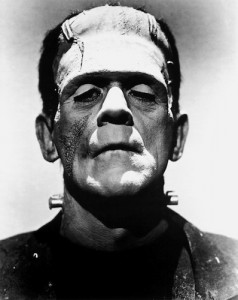
Frankenstein’s Monster (Frankenstein, 1931)
Everyone at one time or another has heard the name Frankenstein. Since the first publication of Mary Shelley’s novel in 1818, the name has become practically a legend in the horror and science fiction genres, and today is even one of the more obvious monster themes associated with Halloween. Even if most people haven’t read the book, many have probably seen at least part of the 1931 film adaptation (especially fans of the Universal Monsters movie series), and it’s on this interpretation of the creature that I based my writing method. While Shelley’s novel leaves the process of the monster’s creation ambiguous, the movie has Dr. Frankenstein build it out of collected limbs and organs that he pieces together into a human body. As for what happens after he brings the body to life, suffice it to say it all goes downhill from there.
Sometimes I like to think of my stories as my own little Frankenstein’s monsters, not in the sense that they’ll unleash untold horror on the world (which some of them might, though it’s too soon to tell), but in the sense that many of them are comprised of prewritten pieces that I later connected by inserting more words in between. Some of them are only a couple of lines long, some are a few paragraphs, and some take up more than a page. But they all come to me “out of turn”.
I spend a lot of time daydreaming about my stories, and a common result of this is the inspiration for a perfectly worded sequence that I haven’t yet reached in the main draft. In order to hold on to these ideas, I often keep a separate file on my computer where I can type them out while they’re still fresh in my mind. After making a note of it, I don’t usually read a scene again until I’ve worked my way up to that point in my story. That’s when the fun of stitching begins.
Stitching the Parts Together
When I have my individual scenes laid out, the next step is to insert them into my stories. While working on the main draft, I’ll eventually come to that part of a story that I had already written in a moment of inspiration. All I have to do then is copy the piece from the separate file I’ve made and paste it into the draft to move on from that point. Simple as that. Usually.
The thing is, it doesn’t necessarily end there. Sometimes after pasting it in, I find that a prewritten scene doesn’t quite fit into the rest of the narrative the way I had anticipated, either because of simple inconsistencies in style or minor details that I had changed since first writing the separate piece. To solve this, I edit the selection to accommodate the newly inserted sequence, revising details in the narrative and/or the added part, until everything fits together like the pieces of a puzzle.
The method doesn’t always work the same way. There are times when I’m struck with the inspiration to write two different scenes that I later realize are close enough in the story’s sequence of events that I can just stitch them together right there on the spot. Other stories of mine have been born from drafts that were nothing but a collection of separate scenes in which I eventually started closing the gaps. But any way I choose to put together the events of a narrative, it’s rarely in the right order. In much the same way I imagine Dr. Frankenstein must have worked to fit all his collected organs into a fully functional body (especially in the novel, where the creature is eight feet tall!), I work to stitch my scattered ideas into complete stories that function well as fiction.
So what writing method works best for you? Do your stories usually unravel in a straight line, or do you stitch them together from separate pieces?

 There’s nothing like exaggeration to get a point across. Who among us hasn’t shared our experiences of “the greatest thing ever”, “the worst day in history”, or “the most fun I’ve ever had in my entire life”? Hyperbole is a common device for creating emphasis, as exaggeration tends to have a great impact on an audience’s perceptions of a given description.
There’s nothing like exaggeration to get a point across. Who among us hasn’t shared our experiences of “the greatest thing ever”, “the worst day in history”, or “the most fun I’ve ever had in my entire life”? Hyperbole is a common device for creating emphasis, as exaggeration tends to have a great impact on an audience’s perceptions of a given description.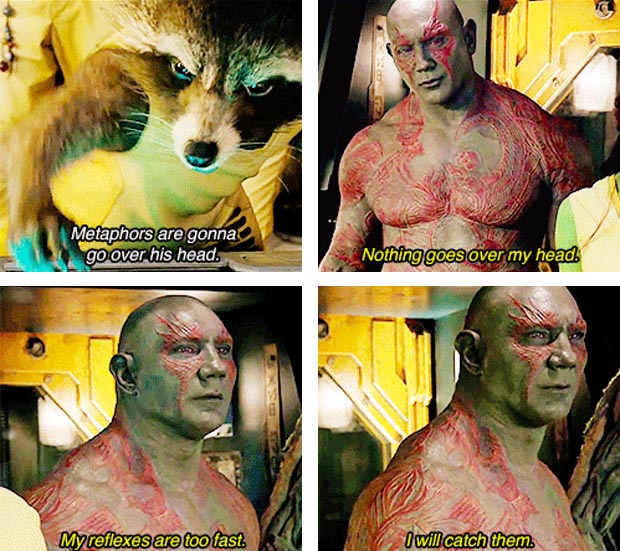

 This one was recently featured as a Word of the Week on my blog. It’s common to hear people use such phrases as “I’m not saying”, “not to mention”, and “needless to say”, only to immediately follow them up with a piece of information they just said they wouldn’t talk about. This is known as paralipsis, an ironic way to draw attention to a subject by explicitly stating you won’t mention it.
This one was recently featured as a Word of the Week on my blog. It’s common to hear people use such phrases as “I’m not saying”, “not to mention”, and “needless to say”, only to immediately follow them up with a piece of information they just said they wouldn’t talk about. This is known as paralipsis, an ironic way to draw attention to a subject by explicitly stating you won’t mention it.




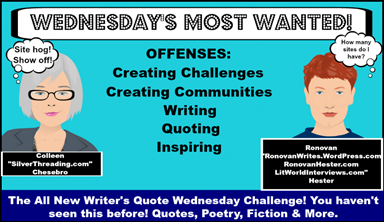


 Red
Red Orange
Orange Yellow
Yellow Green
Green Blue
Blue Purple
Purple Pink
Pink Brown
Brown Gray
Gray White
White Black
Black


Recent Comments